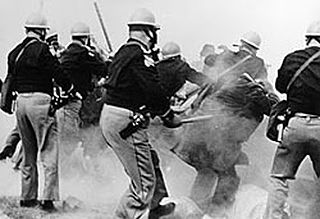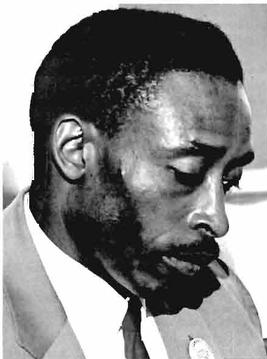
Lowndes County is in the central part of the U.S. state of Alabama. As of the 2020 census, the county's population was 10,311. Its county seat is Hayneville. The county is named in honor of William Lowndes, a member of the United States Congress from South Carolina.

Hayneville is a town in Lowndes County, Alabama, United States and its county seat. At the 2010 census the population was 932, down from its record high of 1,177 in 2000. It is also part of the Montgomery Metropolitan Statistical Area. It initially incorporated in 1831, but lapsed, finally reincorporating in 1967. Before 1970, the town appeared only twice on the U.S. Census: in 1850 and 1890. The 1850 estimate of 800 residents ranked it as the largest town in the county at the time.

The Student Nonviolent Coordinating Committee was the principal channel of student commitment in the United States to the civil rights movement during the 1960s. Emerging in 1960 from the student-led sit-ins at segregated lunch counters in Greensboro, North Carolina, and Nashville, Tennessee, the Committee sought to coordinate and assist direct-action challenges to the civic segregation and political exclusion of African Americans. From 1962, with the support of the Voter Education Project, SNCC committed to the registration and mobilization of black voters in the Deep South. Affiliates such as the Mississippi Freedom Democratic Party and the Lowndes County Freedom Organization in Alabama also worked to increase the pressure on federal and state government to enforce constitutional protections.

Kwame Ture was a prominent organizer in the civil rights movement in the United States and the global pan-African movement. Born in Trinidad, he grew up in the United States from the age of 11 and became an activist while attending the Bronx High School of Science. He was a key leader in the development of the Black Power movement, first while leading the Student Nonviolent Coordinating Committee (SNCC), then as the "Honorary Prime Minister" of the Black Panther Party (BPP), and last as a leader of the All-African People's Revolutionary Party (A-APRP).

The Selma to Montgomery marches were three protest marches, held in 1965, along the 54-mile (87 km) highway from Selma, Alabama, to the state capital of Montgomery. The marches were organized by nonviolent activists to demonstrate the desire of African-American citizens to exercise their constitutional right to vote, in defiance of segregationist repression; they were part of a broader voting rights movement underway in Selma and throughout the American South. By highlighting racial injustice, they contributed to passage that year of the Voting Rights Act, a landmark federal achievement of the civil rights movement.

The Black Power movement was a branch or counterculture within the civil rights movement of the United States, reacting against its more moderate, mainstream, or incremental tendencies and motivated by a desire for safety and self-sufficiency that was not available inside redlined African American neighborhoods. Black Power activists founded black-owned bookstores, food cooperatives, farms, media, printing presses, schools, clinics and ambulance services. The international impact of the movement includes the Black Power Revolution in Trinidad and Tobago.

James Forman was a prominent African-American leader in the civil rights movement. He was active in the Student Nonviolent Coordinating Committee (SNCC), the Black Panther Party, and the League of Revolutionary Black Workers. As the executive secretary of SNCC from 1961 to 1966, Forman played a significant role in the Freedom Rides, the Albany movement, the Birmingham campaign, and the Selma to Montgomery marches.
Ruby Nell Sales is an African-American social justice activist, scholar, and public theologian. She has been described as a "legendary civil rights activist" by the PBS program Religion and Ethics Weekly, and is one of 50 civil rights leaders showcased by the Smithsonian National Museum of African American History and Culture in Washington, DC.

Clayborne Carson is an American academic who is a professor of history at Stanford University and director of the Martin Luther King, Jr., Research and Education Institute. Since 1985, he has directed the Martin Luther King Papers Project, a long-term project to edit and publish the papers of Martin Luther King Jr.
Jack Minnis (1926-2005) was an American activist, and the founder and director of opposition research for the Student Nonviolent Coordinating Committee in the Civil Rights Movement era. Minnis researched federal expenditures and state and local subversion of racial equality. Minnis was white, but remained affiliated with SNCC even after it adopted a "blacks only" personnel policy, its only white employee for a long time. He helped to train such workers as Stokely Carmichael, Marion Barry, and John Lewis.
Black Power is a political slogan and a name which is given to various associated ideologies which aim to achieve self-determination for black people. It is primarily, but not exclusively, used by black people activists and proponents of what the slogan entails in the United States. The Black Power movement was prominent in the late 1960s and early 1970s, emphasizing racial pride and the creation of black political and cultural institutions to nurture, promote and advance what was seen by proponents of the movement as being the collective interests and values of black Americans.
Fay D. Bellamy Powell was an African-American civil rights activist.

Samuel Leamon Younge Jr. was a civil rights and voting rights activist who was murdered for trying to desegregate a "whites only" restroom. Younge was an enlisted service member in the United States Navy, where he served for two years before being medically discharged. Younge was an active member of the Student Nonviolent Coordinating Committee (SNCC) and a leader of the Tuskegee Institute Advancement League.
This is a timeline of the civil rights movement in the United States, a nonviolent mid-20th century freedom movement to gain legal equality and the enforcement of constitutional rights for people of color. The goals of the movement included securing equal protection under the law, ending legally institutionalized racial discrimination, and gaining equal access to public facilities, education reform, fair housing, and the ability to vote.
The Dallas County Voters League (DCVL) was a local organization in Dallas County, Alabama, which contains the city of Selma, that sought to register black voters during the late 1950s and early 1960s.
Robert "Bob" Mants, Jr. was an American civil rights activist, serving as a field secretary for the Student Nonviolent Coordinating Committee (SNCC). Mants moved to Lowndes County, working for civil rights for the remainder of his life. Lowndes County contained the majority of the distance covered by the 1965 Selma to Montgomery march, and was then notorious for its racist violence.

John Hulett was an American civil rights activist, sheriff and judge. He was a leader in the civil rights movement in Lowndes County, Alabama, United States, and the founder of the Lowndes County Christian Movement for Human Rights. He was also the first chairperson of Lowndes County Freedom Organization (LCFO) in 1966, known as the original Black Panther Party.

Dorothy "Dottie" Miller Zellner is an American human rights activist, feminist, editor, lecturer, and writer. A veteran of the 1960s civil rights movement, she served as a recruiter for the Freedom Summer project and was co-editor of Student Voice, the student newsletter of the Student Nonviolent Coordinating Committee. She is active in the Palestinian solidarity movement.
Hasan Kwame Jeffries is a history professor and author at Ohio State University. He is the brother of Congressman Hakeem Jeffries, the House Minority Leader of the United States Congress. He is the nephew of Leonard Jeffries, a former professor at City College of New York.
Gwendolyn Marie Patton is a prominent civil rights activist and educator. Patton’s first steps into the civil rights movement were with the Montgomery Improvement Association (MIA) where she would help African Americans register to vote with her grandparents. During this time, she also began participating in the Montgomery bus boycott. After her time with the MIA, Patton could be seen working with the Student Nonviolent Coordinating Committee (SNCC) at Tuskegee University and the Lowndes County Freedom Organization. Following her time at Tuskegee University, she assisted in establishing both anti-war and human rights organizations that furthermore supported the feminist and Black Power movements, as well as communism, the Cuban Revolution, and marxism. In the 1984 presidential debates, she started her political career as a delegate for Jesse Jackson’s campaign. Then in 1986 as a candidate for Alabama legislature, and finally in 1992 in the U.S. Senate. Patton was also a historian, which helped her to construct the H. Councill Trenholm State Technical College, which is now called the Trenholm State Community College.











